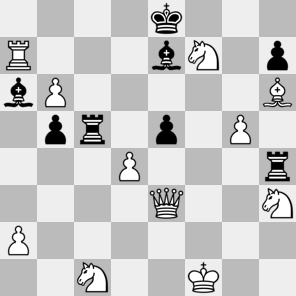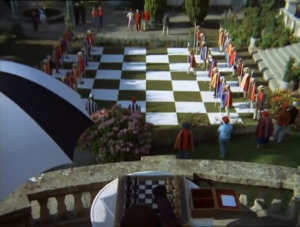I have written about The prisoner before; if you don’t know what it is, you should probably read the first few sentences of that post. But there is more to talk about. In fact, one of the episodes is called Checkmate, which is a pretty good indication that there might be chess involved – and indeed: it starts with a human chess game. If you don’t know what that is, you should probably read the wikipedia article I conveniently linked you to, or read the next sentence, which will give you the short version. In human chess, the pieces are played by humans dressed up to be recognisable as the piece they represent and they follow the commands of their respective team captains who are doing the actual chess playing. (See? I promised, didn’t I?) Our hero, number 6, is called up to play the white queen’s pawn.
The game starts, and immediately the writers resort to a cheap trick to camouflage their lack of chess knowledge: they hide it behind plot. The moves are being called out through a megaphone,1 but meanwhile number 6 has struck up a conversation which is obviously highly important to the story. The first few moves lull the viewer into a false sense of security: 1. e4 e5 2. Nc3 – a perfectly normal Vienna game. Then suddenly:
Black: Knight to knight bishop three.
Huh? I must have misunderstood something. He probably said “knight to king’s bishop three”, i.e. Nf6, which is the main line.
White: Knight to knight five.
Huh?! This technically makes sense, but only in a ‘colorless green ideas sleep furiously’2 kind of way. You can play Nb5, but why would you want to? If black’s previous move should be interpreted as Nc6 instead of Nf6, then playing the bishop to b5 would be perfectly normal, though, so maybe that’s what’s going on?
Black: Bishop to knight four.
Oh, okay, so we’re back to nonsense. Perhaps black intends Bb4, but as a black move this would be ‘bishop to knight five‘.
White: Knight to king’s bishop three.
Aha, we get another overview of the chessboard, so we can finally makes somse sense out of this mess! It turns out that…
…it really was 2. … Nf6, but the two moves after that have not actually been played. Apparently, the pieces are only executing those moves that make sense – I wish I had pieces like that.
Black: Bishop to bishop four.
White: Knight to knight five.
Hey, that’s not a well-defined move! Is it knight to king’s knight five or knight to queen’s knight five? And why do they keep cutting back to shots of people talking about the plot? That’s very distracting.
Black: Knight to knight bishop three.
…and that’s even more distracting! Stop it with this gibberish! You clearly mean ‘knight to bishop three’, so say that! It’s even shorter, for God’s sake! Why are you adding useless syllables, you nincompoops?!
White: Pawn to queen four.
After some prompting, our hero steps two squares forward and the black bishop on c5 addresses him:
Black bishop: Don’t worry! You’re safe, protected by the queen.
This would be bullshit again had black indeed played Nc6 but, as illegal instructions are ignored, he didn’t do so.3 Pawn d4 is therefore only attacked twice and it is also defended twice. Why the knight gets no credit is unclear.
Black: Bishop to queen three.
Here, unfortunately, we lose the thread of the game. The next time we see the board, after a cut to the ever present but ever changing number two, the position is completely changed and only about half of the pieces are left, scattered about seemingly at random. Of course, I scrambled to make a reconstruction, but less than a minute later we were back to the position before black’s last move. Apparently, he didn’t like that one, because he castles instead, leaving his bishop on c5 en prise. We cut back again to the other position, where white’s queen’s rook is walking around on his own initiative. After he has been removed from the board, we get such a nice view that I couldn’t stop myself from making a reconstruction. Here it is:4
 Yeah, scattered about at random seems like a very apt description. What the hell is going on here? How the white b-pawn pass the black one? How did white’s rook end up on a7, his bishop on h6, and his knight on c1? What’s with the black rooks? Where did the black queen go? Why are the kings still in the centre? Who does something like this? Who mistreats his pieces like this?
Yeah, scattered about at random seems like a very apt description. What the hell is going on here? How the white b-pawn pass the black one? How did white’s rook end up on a7, his bishop on h6, and his knight on c1? What’s with the black rooks? Where did the black queen go? Why are the kings still in the centre? Who does something like this? Who mistreats his pieces like this?
I already suggested it in my previous The prisoner post and this episode only confirms my conjecture: these people are in prison for a reason. Or perhaps it is actually an insane asylum.
Realism: 1/5 Is this position realistic? Maybe with a prefix like sur- or ir- or un- or something. Otherwise, it’s a clear no.
Probable winner: White has enough extra pieces to start his own village.
1. [In the old English notation, which was usual there at the time this show aired.] ↩
2. [The phrase was coined by the American Chomsky, hence the missing u in ‘colourless’.] ↩
3. [Which means that white has now played one move more than black, but this is apparently not a problem.] ↩
4. [I you want to start your own village, you can make some diagrams and imprison them.] ↩
